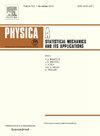Hard rigid rods on Husimi lattices
IF 2.8
3区 物理与天体物理
Q2 PHYSICS, MULTIDISCIPLINARY
Physica A: Statistical Mechanics and its Applications
Pub Date : 2025-02-01
DOI:10.1016/j.physa.2025.130349
引用次数: 0
Abstract
We study the thermodynamic behavior of hard rigid rods of size (i.e., -mers) on four- and six-coordinated Husimi lattices (HLs), respectively built with squares (square HL) and triangles (triangular HL). In both lattices, dimers () and trimers () only present a isotropic phase, whereas a isotropic-nematic transition is observed for . In the square HL, this transition is continuous and occurs at a critical monomer activity which displays a nonmonotonic variation with , while the critical rod activity and density are always decreasing functions of . The isotropic-nematic transition is discontinuous in the triangular HL, but the -dependence of the coexistence activities and density is analogous to that found for the square case. No transition from the nematic to a high-density disordered phase is found in these HLs. In general, this scenario is very similar to that already observed for rods on the Bethe lattice, though the critical parameters obtained her e are in most cases closer to those reported in the literature for the square and triangular lattices. The entropy per site of fully-packed rods is also investigated in detail in the triangular HL, where its value for dimers differs by only 0.7% from the exact result for the triangular lattice.
求助全文
约1分钟内获得全文
求助全文
来源期刊
CiteScore
7.20
自引率
9.10%
发文量
852
审稿时长
6.6 months
期刊介绍:
Physica A: Statistical Mechanics and its Applications
Recognized by the European Physical Society
Physica A publishes research in the field of statistical mechanics and its applications.
Statistical mechanics sets out to explain the behaviour of macroscopic systems by studying the statistical properties of their microscopic constituents.
Applications of the techniques of statistical mechanics are widespread, and include: applications to physical systems such as solids, liquids and gases; applications to chemical and biological systems (colloids, interfaces, complex fluids, polymers and biopolymers, cell physics); and other interdisciplinary applications to for instance biological, economical and sociological systems.

 求助内容:
求助内容: 应助结果提醒方式:
应助结果提醒方式:


